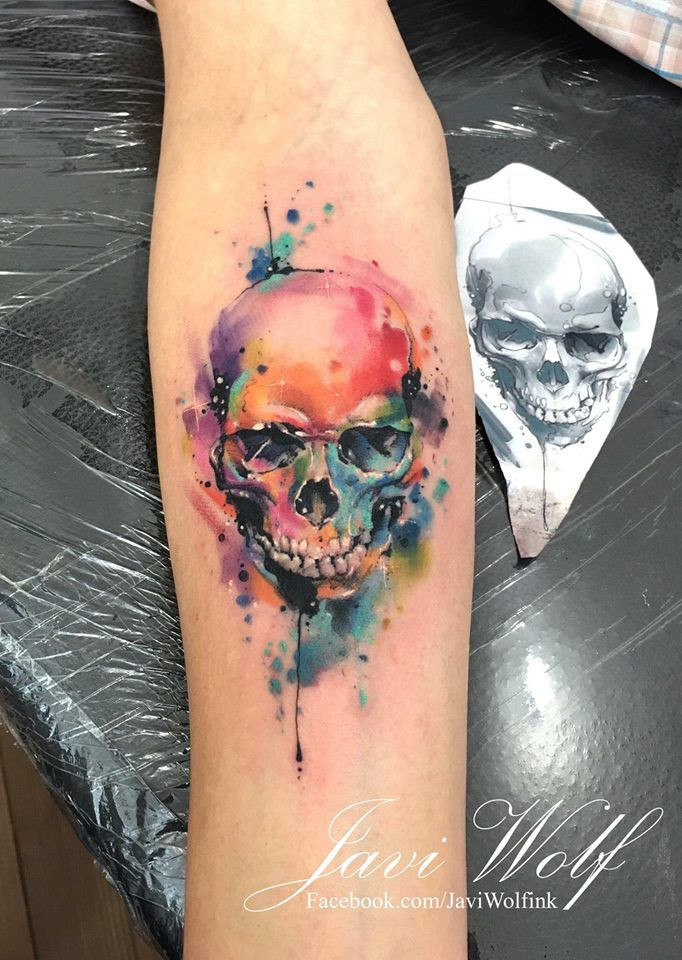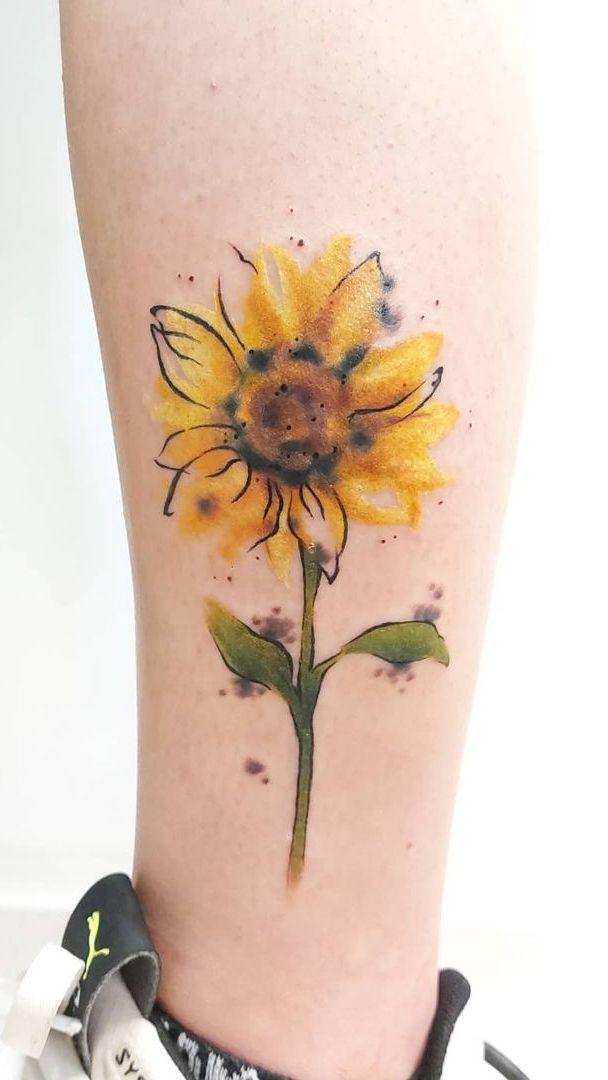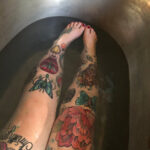Watercolor tattoos are a captivating art form on skin, but does the process sting more than traditional tattoos? Discover the truth behind the pain and the artistry, also explore different tattoo styles on tattooat.com for inspiration. The longevity and vibrancy of any tattoo depend on proper aftercare and lifestyle choices, so explore factors influencing tattoo pain and techniques to minimize discomfort.
1. Understanding Watercolor Tattoos
Watercolor tattoos mimic the delicate, flowing aesthetics of watercolor paintings. Instead of heavy black outlines, artists use blending techniques to create soft transitions between colors, that will appear as if they were brushed directly onto the skin.
1.1. Techniques Used in Watercolor Tattoos
Achieving the watercolor effect requires a mastery of specific techniques:
- Blending: Seamlessly merging colors for a gradient effect.
- Shading: Creating depth and dimension with subtle color variations.
- Fading: Gradually lightening colors to give a soft, airy feel.
- Bleeding: Allowing colors to subtly spread and mix, mimicking the way watercolor paint behaves on paper.
- Runs: Creating the illusion of colors dripping or flowing.
These techniques, when combined, will give the tattoo a unique appearance.
 Watercolor Feather Tattoo on Shoulder
Watercolor Feather Tattoo on Shoulder
2. Pain Perception and Tattoos
Pain is subjective; what one person finds excruciating, another might find tolerable. Several factors influence the pain experienced during a tattoo session.
2.1. Factors Influencing Tattoo Pain
- Location: Areas with more nerve endings or thinner skin tend to be more sensitive.
- Size and Complexity: Larger, more detailed tattoos usually take longer and involve more extensive work.
- Individual Pain Tolerance: People have different thresholds for pain based on genetics, psychological factors, and overall health.
- Artist’s Technique: A skilled artist can minimize pain through efficient techniques and proper needle control.
- Mental State: Anxiety and stress can amplify pain perception.
Understanding these factors can help you prepare for your tattoo experience.
3. Watercolor Tattoos and Pain: The Connection
While the pain of tattooing is universal, some aspects of watercolor tattoos might influence the level of discomfort.
3.1. Layering and Color Application
Watercolor tattoos often require multiple layers of color to achieve the desired blending and shading effects. This layering means the needle passes over the same area of skin multiple times, which can increase pain.
3.2. Lack of Bold Outlines
Traditional tattoos often use bold black outlines as a base. These outlines can provide a sort of “road map” for the artist, allowing them to work efficiently. Watercolor tattoos, lacking these outlines, may require more freehand work and adjustments, potentially prolonging the session and increasing discomfort.
3.3. Comparison to Other Styles
The pain level of a watercolor tattoo is comparable to other tattoo styles that involve extensive shading or color packing. A solid black tattoo, for instance, also requires multiple passes over the same area, resulting in similar levels of pain.
4. Expert Opinions on Watercolor Tattoo Pain
To gain a balanced perspective, here’s what experts and tattoo artists have to say about the pain associated with watercolor tattoos:
4.1. Artist Insights
Many artists agree that the pain level is similar to other styles but can vary depending on the individual and the specific design. According to Inked Magazine, artists often emphasize the importance of communication, encouraging clients to express any discomfort they may be feeling.
4.2. Client Experiences
Online forums and tattoo communities feature a range of experiences. Some individuals report that watercolor tattoos are no more painful than other styles, while others find the prolonged shading more intense.
5. Managing Pain During a Watercolor Tattoo Session
If you’re concerned about pain, several strategies can help you manage discomfort during your tattoo session.
5.1. Preparation is Key
- Get Enough Sleep: Being well-rested can improve your pain tolerance.
- Stay Hydrated: Proper hydration keeps your skin supple and receptive.
- Eat a Meal Beforehand: Maintaining stable blood sugar levels can prevent lightheadedness and increase your ability to withstand pain.
- Avoid Alcohol and Caffeine: These substances can thin your blood and increase sensitivity.
5.2. During the Session
- Communicate with Your Artist: Let them know if you’re feeling overwhelmed or need a break.
- Use Numbing Creams: Topical anesthetics can help reduce pain, but always consult with your artist beforehand.
- Distraction Techniques: Listen to music, watch a movie, or engage in conversation to take your mind off the pain.
- Breathing Exercises: Deep, controlled breathing can help calm your nerves and reduce tension.
5.3. Aftercare and Healing
Proper aftercare is crucial for minimizing pain and promoting healing.
- Follow Your Artist’s Instructions: Adhere to their specific guidelines for cleaning and moisturizing your tattoo.
- Avoid Irritants: Stay away from harsh soaps, tight clothing, and excessive sun exposure.
- Keep it Clean: Gently wash your tattoo with mild soap and water to prevent infection.
- Moisturize Regularly: Use a fragrance-free lotion to keep your skin hydrated and prevent scabbing.
 Watercolor Floral Tattoo on Back
Watercolor Floral Tattoo on Back
6. Longevity and Fading of Watercolor Tattoos
One common concern about watercolor tattoos is their tendency to fade more quickly than traditional tattoos.
6.1. Factors Contributing to Fading
- Lack of Outlines: Without strong outlines to contain the ink, the colors are more susceptible to fading.
- Lighter Colors: Pastel shades and diluted inks fade faster than darker, more saturated colors.
- Sun Exposure: UV rays break down the pigment particles in the ink, leading to fading.
- Skin Type and Location: Tattoos on areas with high friction or sun exposure fade more quickly.
6.2. Tips to Prevent Fading
- Sunscreen: Apply a high SPF sunscreen to your tattoo whenever it’s exposed to the sun.
- Protective Clothing: Cover your tattoo with clothing when spending extended periods outdoors.
- Moisturize: Keep your skin hydrated to prevent the ink from drying out and fading.
- Touch-Ups: Schedule regular touch-up appointments to refresh the colors and lines of your tattoo.
7. Choosing the Right Artist
Selecting a skilled and experienced artist is crucial for a successful and comfortable tattoo experience.
7.1. Qualifications to Look For
- Portfolio: Review their portfolio to ensure they have experience with watercolor tattoos and a style that aligns with your vision.
- Reputation: Read reviews and testimonials from previous clients to gauge their professionalism and skill.
- Consultation: Schedule a consultation to discuss your design ideas and ask any questions you may have.
- Hygiene: Ensure the studio adheres to strict hygiene standards and uses sterile equipment.
7.2. Finding Artists on Tattooat.com
Tattooat.com is a valuable resource for finding talented tattoo artists in your area. The platform features profiles of artists with diverse styles and specialties, including watercolor tattoos.
8. Ideal Placement for Watercolor Tattoos
The location of your tattoo can influence both the pain level and the longevity of the design.
8.1. Areas with Less Pain
- Outer Thigh: Plenty of muscle and fat make this area less sensitive.
- Outer Arm: Similar to the thigh, the outer arm has fewer nerve endings.
- Calf: The muscle in the calf can help cushion the pain.
8.2. Areas to Avoid (Initially)
- Ribs: Thin skin and close proximity to bone make this area particularly painful.
- Feet and Ankles: Many nerve endings and thin skin contribute to increased sensitivity.
- Inner Arm: The skin here is thin and contains numerous nerve endings.
8.3. Placement and Fading
Consider areas that are easily protected from the sun and friction, such as the upper back, thighs, or inner arms.
9. Watercolor Tattoos: Inspiration and Ideas
Watercolor tattoos offer endless possibilities for creativity and self-expression.
9.1. Popular Themes
- Floral Designs: Delicate flowers and leaves create a soft, feminine aesthetic.
- Animal Tattoos: Watercolor techniques can bring animals to life with vibrant colors and flowing lines.
- Abstract Art: Geometric shapes and abstract patterns lend themselves well to the watercolor style.
- Landscapes: Capturing the beauty of nature with soft washes of color.
- Quote Tattoos: Pairing meaningful quotes with watercolor elements adds depth and emotion.
9.2. Finding Inspiration on Tattooat.com
Tattooat.com offers a vast gallery of tattoo designs to inspire your own unique piece of art. Browse through different styles, themes, and artist portfolios to find the perfect inspiration.
10. Overcoming Concerns and Taking the Plunge
If you’re still hesitant about getting a watercolor tattoo, consider these points:
10.1. Addressing Common Fears
- Pain: Remember that pain is temporary and manageable with the right strategies.
- Fading: Proper aftercare and sun protection can significantly extend the life of your tattoo.
- Regret: Choose a design that is meaningful to you and work with a reputable artist to ensure a beautiful and lasting result.
10.2. The Beauty of Self-Expression
Tattoos are a powerful form of self-expression, allowing you to showcase your personality, passions, and beliefs. A watercolor tattoo can be a stunning and unique way to adorn your body with art.
11. Watercolor Tattoo Aftercare
11.1. Immediate Aftercare (First Few Days)
- Keep the Bandage On: Leave the bandage applied by your artist on for the recommended time, usually a few hours.
- Gently Wash: Remove the bandage and gently wash the tattoo with antibacterial, fragrance-free soap and lukewarm water.
- Pat Dry: Pat the area dry with a clean paper towel.
- Apply Ointment: Apply a thin layer of fragrance-free moisturizing ointment recommended by your artist.
- Repeat: Repeat the washing and ointment application 2-3 times a day.
11.2. Ongoing Care (Weeks and Months)
- Moisturize Regularly: Apply a thin layer of fragrance-free lotion several times a day to keep the skin hydrated.
- Avoid Sun Exposure: Keep the tattoo covered and apply sunscreen when exposed to the sun.
- Wear Loose Clothing: Avoid tight clothing that can rub against the tattoo.
- Stay Hydrated: Drink plenty of water to keep your skin healthy.
- Avoid Soaking: No swimming, hot tubs, or long baths until fully healed.
- Don’t Pick or Scratch: Let any scabs fall off naturally to prevent scarring.
11.3. Products to Use
- Antibacterial Soap: Look for fragrance-free, gentle options.
- Fragrance-Free Lotion: Avoid lotions with dyes, perfumes, or alcohol.
- Sunscreen: Use a high SPF, broad-spectrum sunscreen specifically designed for sensitive skin.
12. The Importance of Touch-Ups
12.1. Why Touch-Ups Are Necessary
Watercolor tattoos are prone to fading due to the light colors and lack of bold outlines. Touch-ups help refresh the colors and redefine the lines.
12.2. When to Get a Touch-Up
Most artists recommend getting a touch-up within the first year. Keep an eye on your tattoo and consult your artist when you notice fading or inconsistencies.
12.3. Finding an Artist for Touch-Ups
Ideally, return to the original artist for touch-ups. They will know the exact inks and techniques used. If that’s not possible, find an artist experienced in watercolor tattoos and provide them with as much information as possible about the original work.
13. Addressing the Cost of Watercolor Tattoos
13.1. Factors Influencing Price
- Size and Complexity: Larger, more detailed tattoos cost more.
- Artist’s Experience: Experienced artists typically charge higher rates.
- Location: Prices vary by geographic location.
- Studio Fees: Some studios charge additional fees.
13.2. Budgeting for a Tattoo
Research average prices in your area. Don’t sacrifice quality for a lower price. A well-done tattoo is an investment in your body art.
13.3. Payment Options
Many artists require a deposit when booking an appointment. Discuss payment options with your artist beforehand.
14. Watercolor Tattoos vs. Other Styles: Pain Comparison
14.1. Traditional Tattoos
Traditional tattoos with bold outlines can involve less shading, potentially reducing the overall pain.
14.2. Realism Tattoos
Realism tattoos require intricate shading and layering, similar to watercolor tattoos, leading to comparable pain levels.
14.3. Blackwork Tattoos
Blackwork involves solid areas of black ink, which can be painful due to the extensive color packing.
14.4. Minimalist Tattoos
Minimalist tattoos with fine lines may be less painful due to the smaller amount of ink.
14.5. Conclusion
Watercolor tattoos don’t necessarily hurt more, but the experience is comparable to other styles with extensive shading or color packing.
15. Common Myths About Watercolor Tattoos
15.1. They Wash Off Easily
This is false. The ink is deposited in the dermis layer of the skin, just like any other tattoo.
15.2. They Are Only for Women
Watercolor tattoos are for anyone who appreciates the style, regardless of gender.
15.3. They Don’t Last Long
With proper care, watercolor tattoos can last for many years. Touch-ups are essential to maintain their vibrancy.
15.4. They Are Painless
All tattoos involve some level of pain. Watercolor tattoos are comparable to other styles in terms of discomfort.
16. Preparing for Your Tattoo Appointment
16.1. Mental Preparation
- Relax: Try to stay calm and relaxed.
- Visualize: Imagine the end result and focus on the positive aspects.
- Trust Your Artist: Have confidence in their abilities.
- Communicate: Don’t hesitate to express any concerns.
16.2. Physical Preparation
- Hydrate: Drink plenty of water in the days leading up to your appointment.
- Eat a Meal: Have a good meal before your session to maintain stable blood sugar levels.
- Avoid Alcohol and Caffeine: These substances can increase sensitivity.
- Wear Comfortable Clothing: Choose clothing that allows easy access to the tattoo area.
16.3. What to Bring
- Snacks and Drinks: To keep your energy levels up.
- Entertainment: Music, books, or movies to distract you.
- Numbing Cream: If you’re using one, make sure to apply it as directed.
- Comfort Items: A pillow or blanket if you anticipate a long session.
17. Tattoo Pain Chart
| Body Part | Pain Level | Description |
|---|---|---|
| Outer Thigh | Low | Plenty of muscle and fat. |
| Outer Arm | Low | Similar to the thigh, fewer nerve endings. |
| Calf | Low | Muscle helps cushion the pain. |
| Upper Back | Medium | Fewer nerve endings than other areas. |
| Forearm | Medium | Moderate pain level. |
| Shoulder | Medium | Bony but bearable. |
| Ribs | High | Thin skin and close to bone. |
| Feet/Ankles | High | Many nerve endings and thin skin. |
| Inner Arm | High | Thin skin with numerous nerve endings. |
| Sternum | High | Thin skin over bone. |
| Head/Face | Very High | Numerous nerve endings. |
| Hands/Fingers | Very High | Thin skin and lots of nerve endings. |
| Spine | Very High | Many nerve endings and close proximity to bone. |
| Stomach | Very High | High sensitivity and stretching skin. |
| Inner Thigh | Very High | Sensitive skin and nerve endings. |
| Armpit | Very High | Concentrated nerve endings. |
| Behind the Knee | Very High | Sensitive area with many nerve endings. |
| Elbow | Very High | Skin very close to bone. |
| Genitals | Very High | Very sensitive skin and nerve endings. |
| Behind the Ear | Very High | Skin close to bone and many nerve endings. |
18. Final Thoughts: Embrace the Art
Watercolor tattoos are a beautiful and unique way to express yourself. While they may involve some discomfort, the results can be stunning and rewarding. By understanding the process, managing your pain, and taking proper care of your tattoo, you can enjoy your watercolor masterpiece for years to come.
Find inspiration, connect with talented artists, and learn everything you need to know about tattoos at tattooat.com. Explore designs, read articles, and join a community of tattoo enthusiasts. Your perfect tattoo awaits!
If you’re in Portland, OR, feel free to visit us:
Address: 1825 SW Broadway, Portland, OR 97201, United States
Phone: +1 (503) 725-3000
Website: tattooat.com
19. Frequently Asked Questions (FAQ)
19.1. Do watercolor tattoos hurt more than black and grey tattoos?
Watercolor tattoos may involve similar pain levels to black and grey tattoos, as both often require extensive shading and layering to achieve the desired effect. The perceived pain can vary depending on individual pain tolerance and the specific area being tattooed.
19.2. Why do watercolor tattoos fade faster?
Watercolor tattoos tend to fade more quickly due to the lack of bold outlines and the use of lighter, diluted inks, which are more susceptible to breaking down over time with sun exposure and other environmental factors.
19.3. How can I make my watercolor tattoo last longer?
To prolong the life of your watercolor tattoo, consistently apply high-SPF sunscreen, keep the area moisturized, avoid prolonged sun exposure, and schedule regular touch-up appointments with your tattoo artist to refresh the colors.
19.4. What are the best locations for watercolor tattoos to minimize pain?
Areas with more muscle and fat, such as the outer thigh, outer arm, and calf, tend to be less sensitive and are good options for minimizing pain during a watercolor tattoo session.
19.5. How much does a watercolor tattoo typically cost?
The cost of a watercolor tattoo varies based on size, complexity, artist experience, and location, but budgeting and researching average prices in your area can help ensure you get a high-quality tattoo without overspending.
19.6. Can I use numbing cream for a watercolor tattoo?
Yes, topical numbing creams can help reduce pain during a watercolor tattoo session. Consult with your artist before applying any numbing cream to ensure it won’t interfere with the tattooing process or ink quality.
19.7. What should I do immediately after getting a watercolor tattoo?
Immediately after getting your tattoo, keep the bandage on as directed by your artist, then gently wash the area with antibacterial soap, pat dry, and apply a thin layer of fragrance-free moisturizing ointment.
19.8. How often should I moisturize my watercolor tattoo?
Moisturize your watercolor tattoo several times a day with a fragrance-free lotion to keep the skin hydrated and prevent the ink from drying out.
19.9. Are watercolor tattoos only for women?
No, watercolor tattoos are not exclusive to any gender and can be a beautiful choice for anyone who appreciates the style and artistry.
19.10. How do I find a good artist for watercolor tattoos?
Find a reputable artist by reviewing their portfolio, reading client testimonials, scheduling a consultation, and ensuring the studio adheres to strict hygiene standards.

